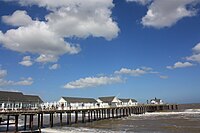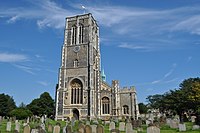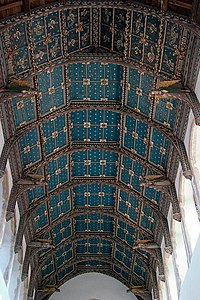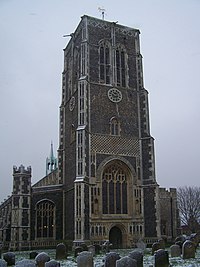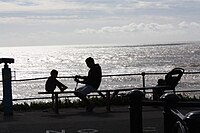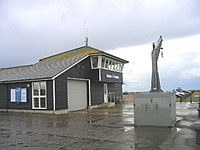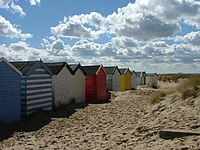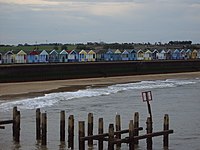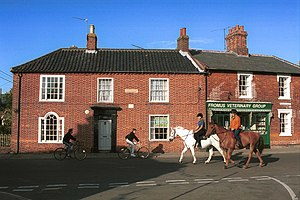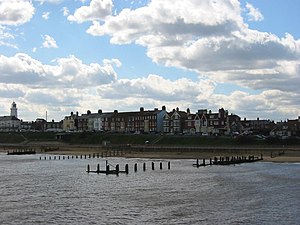Southwold
| Southwold | |
| Suffolk | |
|---|---|
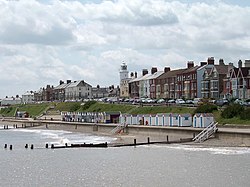 Southwold sea front | |
| Location | |
| Grid reference: | TM510763 |
| Location: | 52°19’37"N, 1°40’48"E |
| Data | |
| Population: | 1,458 (2001) |
| Post town: | Southwold |
| Postcode: | IP18 |
| Dialling code: | 01502 |
| Local Government | |
| Council: | East Suffolk |
| Parliamentary constituency: |
Suffolk Coastal |
Southwold is a small, thriving seaside resort town on the North Sea coast of Suffolk. It is at the mouth of the River Blyth and all within that stretch of broad, sandy Suffolk coastland that charms the imagination of its many visitors. The "Suffolk Coast and Heaths Area of Outstanding Natural Beauty" includes Southold.
Southwold has a somewhat more genteel reputation than the brash resorts up the coast, though it is still very busy in the summertime.
The town is around 11 miles south of Lowestoft and 29 miles north-east of Ipswich.
Contents
History
Southwold is listed in Domesday Book of 1086. It was a fishing port and after the "capricious River Blyth withdrew from Dunwich in 1328, bringing trade to Southwold in the 15th century",[1] it received its town charter from Henry VII in 1489.
The Suffolk coast is a fickle thing however and over the following centuries, however, a shingle bar built up across the harbour mouth, preventing the town from becoming a major Early Modern port: "The shingle at Southwold Harbour, the mouth of the Blyth, is ever shifting," William Whittaker observed in 1887.[2]
The Reformation tradition was strong in this part of Suffolk, and Southwold home to a number of Puritan emigrants to the Massachusetts Bay Colony in the 1630s, notably a party of 18 assembled under Rev Young, which travelled in the Mary Ann in 1637.[3] Richard Ibrook, born in Southwold and a former bailiff of the town, emigrated to Hingham, Massachusetts, along with Rev Peter Hobart, son of Edmund Hobart of Hingham, Norfolk; Hobart had been an assistant vicar of St Edmund's Church, Southwold after graduating from Magdalene College, Cambridge.
In 1659 a fire devastated most of the town and damaged St Edmund's Church, whose original structure dated from the 12th century. The fire created a number of open spaces within the town which were never rebuilt. Today this "series of varied and very delightful village greens"[4] and the restriction of expansion because of the surrounding marshes, have preserved its genteel appearance.
On the green just above the beach, descriptively named Gun Hill, the six 18-pounder cannon commemorate the Battle of Sole Bay, fought in 1672 between English and French fleets on one side and the Dutch (under Michiel de Ruyter) on the other. The battle was bloody but indecisive and many bodies were washed ashore. Southwold Museum has a collection of mementos of the event. It has occasionally been said that these cannon were captured from the Jacobites at the Battle of Culloden and given to the town by the Duke of Cumberland, but they are much larger than those used in that campaign. During World War I, it was widely thought that these cannon were one reason why this part of the coast was bombarded by the German Fleet as a "fortified coast". In Second World War the cannon were removed, and returned to their former position after hostilities.
Economy
Although once home to a number of different industries, Southwold's economy nowadays is mainly based on services, particularly hotels, holiday accommodation, catering, and tourism. With the surrounding areas largely given over to agriculture, the town is an important commercial centre for the area, with many independent shops and a market on Mondays and Thursdays. However, there has been a marked trend in recent years for retailing chains, including food, clothing and stationery shops, to take over formerly independent retail premises.[5]
Adnams Brewery is located in Southwold, and is the town's largest single employer. Although the fishing fleet and the industry generally is much diminished, Southwold Harbour remains one of the main fishing ports on the Suffolk coastline. In 2012, additional facilities for the fleet were constructed there, as part of the repair and reinstatement of the Harbour's North Wall.
Landmarks and features
Lighthouse
Southwold lighthouse was commissioned in 1890 and automated and electrified in 1938.[6] It stands as a prominent landmark in the centre of the town and is a Grade II listed building.[7] It is 101.7 feet (31.0 m) metres tall, standing 121.4 feet (37.0 m) metres above sea level. It is built of brick and painted white and has 113 steps around a spiral staircase.[8]
The lighthouse replaced three local lighthouses that were under serious threat from coastal erosion. It suffered a fire in its original oil fired lamp just six days after commissioning but survived and today operates a rotating 150 watt lamp with a range of 24 nautical miles.[6][9][10][11] Guided visits are run by the Southwold Millennium Foundation.[8]
Brewery
Adnams Brewery was established in the town by George and Ernest Adnams in 1872 with the purchase of the Sole Bay Brewery which had been established in 1818.[12][13][14] In 1890 the brewery was re-built on its site in the centre of the town. The brewery is the town's largest employer[13] and has been modernised and expanded in recent years with the development of an energy efficient brewery, a new distribution centre outside the town and a distillery.[12][13][14] In 2011 it received the Good Pub Guide Brewery of the Year Award.[15]
Pier
Southwold Pier was built in 1900, and, at 810 feet was long enough to accommodate the Belle steamers which carried trippers along the coast. In Second World War, it was weakened by having two breaches blown in it and in 1955 a gale destroyed a large part of it. The pier was entirely rebuilt and restored in 2001 and is now about 623 feet long. Whilst many seaside piers are in decline, Southwold Pier is enjoying renewed popularity - the pier includes a collection of modern coin-operated novelty machines made by Tim Hunkin and paddle steamers such as PS Waverley and the MV Balmoral occasionally berth at the pier.
A model boat pond adjacent to the pier is used for the Southwold Model yacht regattas which have been held since the late Victorian period.[16] Some of the boats entered are up to 80 years old and include replicas of beach yawls. Regattas are usually held in the spring and summer with the largest, the annual regatta, held at the end of the summer season.
Water towers
The Old Water Tower, in the middle of Southwold Common, was built in 1890. The tank held 40,000 gallons of water and was powered by huge sails. On St Valentine's Day 1899 George Neller, a respected local man, died when his coat got caught in its machinery. In 1937 a new 150,000 gallon capacity Art Deco water tower was built next door. The then Southwold Borough Council bought the Old Water Tower before it came into the hands of successive water companies. It was returned to the Town Council for a nominal fee of £100 in 1987. The Old Water Tower has since been used as the Lifeboat museum and was later used by Adnams for a number of years.
Southwold Museum
Southwold Museum holds a number of exhibits focussed on the local and natural history of the town. The museum is owned and managed by the Southwold Museum & Historical Society. It is part of the Maritime Heritage East programme which unites 43 maritime museums on the East Coast.
St Edmund's Church
The parish church of Southwold is dedicated to St Edmund. It is considered to be one of Suffolk's finest.[17] The church lies under one continuous roof. It was built over about 60 years from the 1430s to the 1490s, and replaced a smaller 13th-century church that was destroyed by fire. The earlier church dated from the time when Southwold was a small fishing hamlet adjacent to the larger Reydon. By the 15th century Southwold was an important town in its own right, and the church was rebuilt to match its power and wealth.
The church is renowned for its East Anglian flushwork, especially that of the tower. Knapped and unknapped flints are arranged in patterns, textures and designs and create the stone work. The curving letters over the west window are most famous pre-Reformation plea: SCT. EDMUND ORA P. NOBIS (St Edmund pray for us). Each letter is crowned, and set in knapped flints. The church has a copper clad roof with an easily recognisable flèche (or spirelet), above a clerestory of eighteen windows. The flèche was purely for display, and has never contained a bell. The tower has no parapet and is a very fine piece of architecture, with its large bell openings. The roof of the nave is so high that it makes the tower seem shorter than it really is; but it is at least 100 feet high. All of the church's mediæval glass was destroyed by William Dowsing in 1644; the only stained glass windows in the church are the east windows over the altar (1954, by Sir Ninian Comper) and the west window below the grand tower.
During the Second World War the church was narrowly missed by a German bomb that destroyed houses in the nearby Hollyhock Square. The bomb did not do much damage to the building itself but blew out most of the windows - another reason why the church has very little stained glass. The church was tidied very quickly for the funerals, a short while later, of the people killed by the bomb.
In the interior, the rood screen is considered by many to be the finest in the county. It stretches all the way across the church, and is made up of three separate screens: a rood screen across the chancel arch and parclose screens across the north and south chancel aisles. A 15th-century clock jack stands at the west end. He has an axe and bell which he uses to strike the time, and has a twin at Blythburgh. The Southwold jack is named "Southwold Jack", and is one of the symbols of the Adnams brewery. The font has been badly mutilated but is still very impressive with its large ornate cover. The roof in the chancel is painted and its height gives the church a very open feeling.
Present-day church community life is extremely diverse and makes good use of St Edmund's Hall (also destroyed during the Second World War and rebuilt) to the rear of the church. The parish of Southwold is part of the Sole Bay Team Ministry, along with the Parishes of Blythburgh, Sotherton, Reydon, South Cove, Uggeshall, Walberswick and Wangford.
Church bells
Southwold tower contains a ring of eight bells hung for change ringing. The tower held five bells in 1553. Over the years these bells have been recast and others added to create the current eight. The current fourth and fifth are probable recasts of the originals, having been cast in 1668 by John Darbie of Ipswich. The third dates from 1820 and is by William Dobson of Downham Market. In 1828 one bell was recast and a further two added. The bell that was recast is the present tenor, also by William Dobson. The sixth and seventh were added and are likely to originate from All Saints, South Elmham. Both are mediæval bells, the sixth being cast around 1538 by William Barker and the seventh by Brasyers of Norwich around 1513. The two trebles date from 1881 and are by Moore, Holmes & Mackenzie of Redenhall, Norfolk.[18] However, a peal of Oxford Treble Bob Major was rung on 26 July 1858, indicating that the tower possessed a ring of eight prior to 1881.[19]
In 1990 the bells were rehung on new fittings and the frame strengthened by the Whitechapel Bell Foundry. There is a large amount of space surrounding the frame, allowing ease of access and maintenance. The clock uses the seventh bell to strike the hours. There are no bells in the tower other than the ringing peal. The bells are rung from a ringing chamber some 52 steps up the tower. The chamber has many mementos of past campanological achievements. The tower is affiliated to the Suffolk Guild of Ringers. The bells are rung regularly for Sunday services, weddings and other special occasions.[18]
Southwold harbour
Southwold harbour lies south of the town on the River Blyth. The harbour extends nearly a mile upstream from the river mouth, and is mainly used by fishing boats, yachts and small pleasure boats. The clubhouse of Southwold Sailing Club is on the north side of the harbour.
The quay and area in front of the Harbour Inn is called "Blackshore", although this name is often, but incorrectly, used to refer to the whole harbour.
At the seaward end of the harbour is Southwold Lifeboat Station operated by the RNLI. The former Cromer lifeboat shed houses the Alfred Corry museum. This features the former Southwold lifeboat "Alfred Corry", which was in service from 1893 to 1918. The boat is currently being restored to her original state.
The river can be crossed on foot or bicycle by a public footbridge (partly the old railway bridge) upstream from The Harbour Inn, which gives access to the village of Walberswick. This bridge, known as the Bailey Bridge, is based on the footings of the original railway bridge. It replaced that bridge, which contained a swinging section to allow the passage of wherries and other shipping, and which was largely demolished at the start of Second World War as a precaution against German invasion.
Towards the mouth of the River Blyth, a rowing boat ferry service runs between the Walberswick and Southwold banks. The ferry has been operated by the same family since the 1920s, when it was a chain ferry that could take cars. The chain ferry ceased working in 1941, but some small vestiges remain at the Walberswick slipway.
Southwold beach
The beach is a combination of sand and shingle. In 2005/6 it was further protected by a coastal management scheme which includes beach nourishment, new groynes on the south side of the pier and riprap to the north.
The beach is overlooked by brightly painted beach huts: an astounding number of these huts line the whole sea front, zealously maintained and variously, sometimes peculiarly, decorated by their owners, they are one of the most striking aspects of the whole town.
Popular culture
The fictional Southwold Estate, seat of the equally fictional Earls of Southwold, is the country estate of the family of Lady Marjorie Bellamy in the ITV British drama Upstairs, Downstairs.
The town and its vicinity has been used as the setting for numerous films and television programmes, including Iris about the life of Iris Murdoch starring Judi Dench; Drowning by Numbers by Peter Greenaway; Kavanagh QC starring John Thaw; 'East of Ipswich' by Michael Palin; Little Britain with Matt Lucas and David Walliams; and a 1969 version of David Copperfield.[20]
The BBC children's series Grandpa In My Pocket was filmed in Southwold, Walberswick and Aldeburgh, in which the town appears as "Sunnysands"[21] Only exteriors of buildings were filmed - no acting was done there, but it brings many young visitors to see.
ITV drama, A Mother's Son, was recently filmed on location in Southwold. It was broadcast on ITV1 in September 2012.
George Orwell
The writer George Orwell (whose real name was Eric Blair) spent time as a teenager and in his thirties in Southwold, living at his parents' home. A plaque can be seen next door to what is now the fish and chip shop at the far end of the High Street.
From January to June 1922 he attended a cramming establishment in Southwold to prepare for his Indian Police Service exams and his career in Burma. In 1929 after eighteen months in Paris he returned to the family home at Southwold and spent most of the next five years based at Southwold. He tutored a disabled child and a family of three boys during this time and wrote reviews and developed Burmese Days. During this period he spent nearly eighteen months teaching in Middlesex until he had a serious bout of pneumonia. His mother then insisted that he stay at home instead of carrying on teaching and he spent the time writing A Clergyman's Daughter. The novel is partly set in a fictionalised East Anglian town called "Knype Hill". His final visit to Southwold was in 1939.
Cultural events
In 2005, Southwold launched Suffolk's "answer to the Turner prize", the "Flying Egg" competition. This event also ran in 2006 and 2007, but was not repeated in 2008.[22]
Outside links
| ("Wikimedia Commons" has material about Southwold) |
- A Short History of the Southwold Railway
- Southwold Museum
- A history of Southwold's shops and trades
- Online edition of free monthly newspaper Southwold Organ
- The "Alfred Corry" Museum
- Southwold Guided Tour
- Southwold Online
- Explore Southwold
References
- ↑ Norman Scarfe, Suffolk in the Middle Ages: Studies in Places and Place-Names, 2004:161
- ↑ W. Whitaker, The Geology of Southwold, and of the Suffolk coast from Dunwich to Covehithe: (Explanation of sheet 49 N.) 1887: "Coast deposits" pp 45ff; the coastal spits and bars are discussed in J. Steers, "The East Anglian Coast", The Geographical Journal 69.1, January 1927.
- ↑ Roger Thompson, Mobility and Migration: East Anglian Founders of New England, 1629-1640 2009:188, et passim.
- ↑ Scarfe 2004:125.
- ↑ "Organisation warns Southwold's unique character could be lost". Lowestoft Journal. 27 April 2012. http://www.lowestoftjournal.co.uk/news/organisation_warns_southwold_s_unique_character_could_be_lost_1_1361359.
- ↑ 6.0 6.1 Southwold, Trinity House. Retrieved 2012-10-29.
- ↑ The Lighthouse, Southwold, British Listed Building. Retrieved 2012-10-29.
- ↑ 8.0 8.1 See inside a lighthouse, Trinity House. Retrieved 2012-10-29.
- ↑ Application note 32064 - Southwold Conversion, Pelangi. Retrieved 2013-01-04.
- ↑ Discovering Southwold, BBC Suffolk. Retrieved 2012-10-29.
- ↑ The sea - Southwold's lighthouse, Southwold museum. Retrieved 2012-10-29.
- ↑ 12.0 12.1 Suffolk brewer Adnams starts distillery, BBC news website, 2010-11-12. Retrieved 2013-01-02.
- ↑ 13.0 13.1 13.2 Point 7 - The Brewery, BBC Suffolk. Retrieved 2013-01-02.
- ↑ 14.0 14.1 Our history, Adnams. Retrieved 2013-01-02.
- ↑ Adnams claims national title, Eastern Daily Press, 2010-10-07. Retrieved 2013-01-02.
- ↑ The SMYR Handbook, Southwold Model Yacht Regattas. Retrieved 2012-10-30.
- ↑ "Simon Jenkin's top Suffolk churches". Suffolkchurches.co.uk. http://www.suffolkchurches.co.uk/abjenkins.htm. Retrieved 2013-02-23.
- ↑ 18.0 18.1 Taken from Doves Guide. 27th January 2009.
- ↑ Taken from Felstead Database. 5 September 2011.
- ↑ "David Copperfield". Old City. 2004-11-08. http://www.oldcity.org.uk/norwich/film/copperfield1.php. Retrieved 2013-02-23.
- ↑ BBC press release Retrieved 26 April 2012
- ↑ "Telegraph news 01/08/2005". Telegraph.co.uk. http://www.telegraph.co.uk/news/main.jhtml?xml=/news/2005/08/01/nart01.xml&DCMP=OTC-Autonolnk. Retrieved 2013-02-23.
External sources
- Munn, Geoffrey, Southwold: An Earthly Paradise, Antique Collectors Club, (Woodbridge, 2006) ISBN 1851495185
